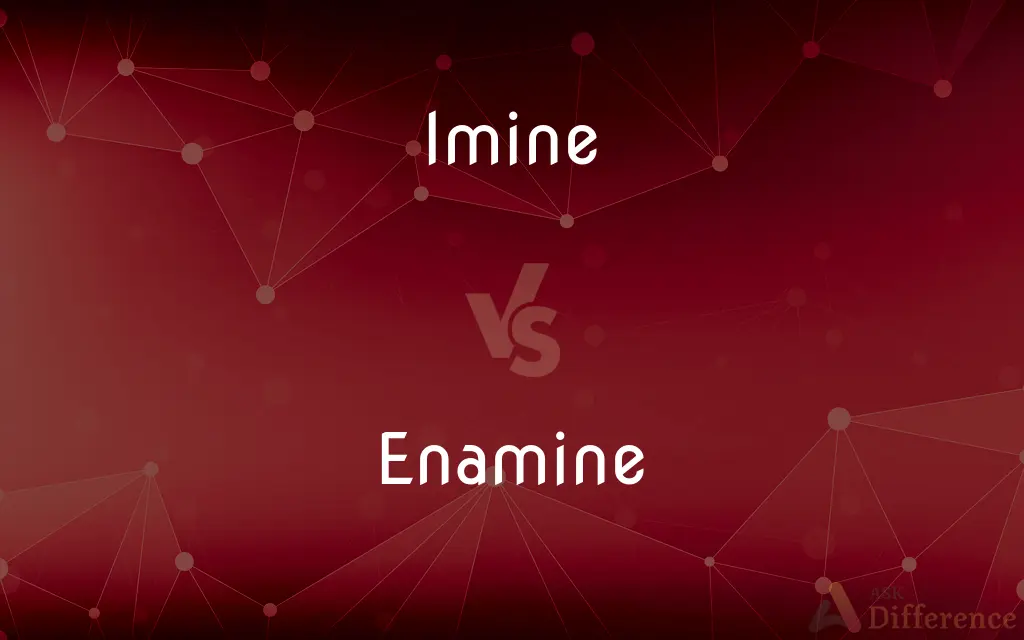Imine vs. Enamine — What's the Difference?
Edited by Tayyaba Rehman — By Fiza Rafique — Updated on March 21, 2024
Imines are organic compounds with a carbon-nitrogen double bond, while enamines have a carbon-nitrogen single bond adjacent to a carbon-carbon double bond.

Difference Between Imine and Enamine
Table of Contents
ADVERTISEMENT
Key Differences
Imines are characterized by the presence of a carbon-nitrogen double bond (C=N), where the nitrogen atom is typically bonded to a hydrogen atom or an alkyl or aryl group. These compounds are often formed through the condensation of primary amines with aldehydes or ketones, releasing water as a byproduct. Whereas enamines are derived from secondary amines and aldehydes or ketones, featuring a carbon-nitrogen single bond (C−N) adjacent to a carbon-carbon double bond (C=C), forming a conjugated system.
The synthesis of imines involves the dehydration of the primary amine and carbonyl compound, which can be catalyzed by acids. On the other hand, the synthesis of enamines typically requires the removal of water from a secondary amine and a carbonyl compound, a process that also benefits from acidic conditions to facilitate the formation of the enamine structure.
In terms of reactivity, imines are versatile intermediates in organic synthesis, often serving as electrophiles in nucleophilic addition reactions or in cycloaddition reactions. Enamines, due to their conjugated system, act as nucleophiles in various organic reactions, including alkylation and acylation, making them useful for the synthesis of complex organic molecules.
Chemically, imines can be hydrolyzed back to the original amine and carbonyl compound under acidic or basic conditions, highlighting their reversibility. Enamines, while also reversible to their starting materials, showcase unique stability due to the resonance between the nitrogen atom and the adjacent double bond, which delocalizes the electron density across the molecule.
The distinction between imines and enamines lies not only in their structural differences but also in their synthetic applications and chemical reactivity. Imines are key intermediates in the synthesis of amines, amides, and other nitrogen-containing compounds, while enamines are exploited for their nucleophilic character in C-C bond-forming reactions, such as the Michael addition or the Aldol reaction.
ADVERTISEMENT
Comparison Chart
Structural Feature
Carbon-nitrogen double bond (C=N)
Carbon-nitrogen single bond (C−N) adjacent to a C=C bond
Formation
From primary amines and carbonyl compounds
From secondary amines and carbonyl compounds
Reactivity
Acts as electrophiles in addition reactions
Acts as nucleophiles in C-C bond-forming reactions
Synthesis Conditions
Acid-catalyzed dehydration
Acid-catalyzed dehydration
Chemical Stability
Hydrolyzable under acidic or basic conditions
Stable due to resonance between N and adjacent C=C bond
Compare with Definitions
Imine
A compound with a C=N bond.
The Schiff base is a well-known example of an imine.
Enamine
Features a C−N bond adjacent to a C=C.
Pyrrolidine and cyclohexanone form an enamine.
Imine
Formed by condensation of primary amines.
The reaction of benzaldehyde with aniline produces an imine.
Enamine
Stability enhanced by resonance.
The electron density in enamines is delocalized across the molecule.
Imine
Acts as electrophiles.
Imines undergo nucleophilic addition reactions.
Enamine
Derived from secondary amines.
The reaction of cyclohexanone with morpholine produces an enamine.
Imine
Can be hydrolyzed.
Imines revert to amines and aldehydes upon hydrolysis.
Enamine
Utilized in C-C bond formation.
Enamines are used in the Michael addition reaction.
Imine
Used in organic synthesis.
Imines are intermediates in the synthesis of various nitrogen-containing compounds.
Enamine
Acts as nucleophiles.
Enamines participate in alkylation reactions.
Imine
An imine ( or ) is a functional group or chemical compound containing a carbon–nitrogen double bond. The nitrogen atom can be attached to a hydrogen (H) or an organic group (R).
Enamine
An enamine is an unsaturated compound derived by the condensation of an aldehyde or ketone with a secondary amine. Enamines are versatile intermediates.
Imine
A highly reactive organic compound containing an NH group doubly bonded to a carbon atom.
Enamine
An organic compound containing an amine group bonded to a carbon atom, which in turn is doubly bonded to another carbon atom.
Imine
(organic chemistry) Any of a class of organic nitrogen compounds having the general formula R2C=NR; they are tautomeric with enamines.
Enamine
(organic chemistry) Any of a class of unsaturated nitrogen compounds, having the general formula R2C=C(R)-NR2, prepared by the condensation reaction of an aldehyde or ketone with an secondary amine; they are the tautomeric forms of imines.
Enamine
An amine containing the double bond linkage -C=C-N-
Common Curiosities
What are the typical uses of imines in organic synthesis?
Imines are used as intermediates in the synthesis of amines, amides, and other nitrogen-containing organic compounds.
Can imines and enamines be interconverted?
While imines and enamines are not directly interconvertible, they can both be synthesized from carbonyl compounds using primary or secondary amines, respectively.
How are enamines different from imines?
Enamines differ by having a carbon-nitrogen single bond adjacent to a carbon-carbon double bond, forming a conjugated system.
What defines an imine?
An imine is defined by the presence of a carbon-nitrogen double bond (C=N) in its structure.
How do enamines participate in organic reactions?
Enamines act as nucleophiles in various C-C bond-forming reactions, including alkylation, acylation, and the Aldol reaction.
Are imines and enamines stable?
Imines are hydrolyzable under acidic or basic conditions, while enamines are relatively stable due to resonance stabilization.
Can enamines revert to their starting materials?
Yes, enamines can be hydrolyzed under certain conditions to yield the original carbonyl compound and amine.
What role does acidity play in the formation of imines and enamines?
Acidic conditions facilitate the dehydration necessary for the formation of both imines and enamines.
What is the significance of the conjugated system in enamines?
The conjugated system in enamines allows for electron delocalization, enhancing their chemical stability and reactivity.
What makes enamines unique in organic chemistry?
Enamines are unique due to their nucleophilic character and stability, making them valuable in C-C bond-forming reactions.
How does the chemical reactivity of imines and enamines differ?
Imines primarily act as electrophiles, while enamines are nucleophilic due to their ability to donate electrons in reactions.
How are imines identified in a chemical structure?
Imines are identified by looking for the characteristic carbon-nitrogen double bond within the molecule.
Why are enamines important in synthesis?
Enamines are important in synthesis for their ability to form new carbon-carbon bonds, facilitating the construction of complex organic molecules.
Share Your Discovery

Previous Comparison
Rapid vs. Waterfall
Next Comparison
Inconsistent vs. InconstantAuthor Spotlight
Written by
Fiza RafiqueFiza Rafique is a skilled content writer at AskDifference.com, where she meticulously refines and enhances written pieces. Drawing from her vast editorial expertise, Fiza ensures clarity, accuracy, and precision in every article. Passionate about language, she continually seeks to elevate the quality of content for readers worldwide.
Edited by
Tayyaba RehmanTayyaba Rehman is a distinguished writer, currently serving as a primary contributor to askdifference.com. As a researcher in semantics and etymology, Tayyaba's passion for the complexity of languages and their distinctions has found a perfect home on the platform. Tayyaba delves into the intricacies of language, distinguishing between commonly confused words and phrases, thereby providing clarity for readers worldwide.















































